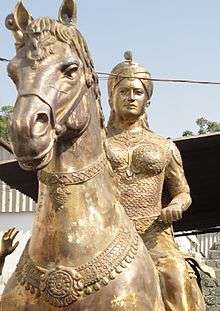Rudrama Devi
| Rudrama Devi | |
|---|---|
 Statue of Rani Rudhramadevi
succession = | |
| Predecessor | Ganapathideva |
| Successor | Prataparudra II |
| Died |
27 November 1289 A.D Chandupatla (now in Telangana, India) |
| Spouse | Chalukya Veerabhadrudu |
| Dynasty | Kakatiya |
| Father | Ganapathideva |
Rani Rudrama Devi (1245–1289), Telugu రుద్రమ దేవి or Rudradeva Maharaja,[1] sometimes spelled Rudramadevi, was a ruler of the Kakatiya dynasty in the Deccan Plateau and one of the few ruling queens in Indian history.

Birth
Rudrama Devi was known as Rudrāṃbā at birth. Her father was Ganapatideva. Ganapatideva married Naramma and peramma. Ganapatideva brother-in-law was Jayapanadu, he was military commander of kakatiya ganapatideva. They were from Durjaya vamsa, the emperor of the Kakatiya dynasty who ruled from Orugallu, now known as Warangal, in Telangana. Rudrama was formally designated as a son through the ancient Putrika ceremony[2] and given the male name of Rudradeva.[3]
Rule
Rudrama Devi has begun to rule the kingdom jointly with her father as his co-regent from 1259-60 under the name of Rudradeva Maharaja. In the first two or three years of their joint rule, the kingdom was thrown into confusion and disorder due to Jatavarma Sundara Pandya I's invasion and the disastrous defeat of the Kakatiyas and their allies on the battle field of Muttukur, near Nellore. Though Ganapatideva was ultimately successful in turning back the tide of invasion, he suffered loss of territory and prestige and his hold over his feudatories and nobles was shaken. Under these circumstances, he retired from active politics.
Rudramma Devi succeeded her father to the Kakatiya throne at the age of 14, assuming the title Rani (Queen) and the name Rudradeva. Though she assumed full sovereignty in 1262-63 AD, she was not the crowned queen until 1269, which was when her father died. Her nomination and ascension to the throne was not entirely accepted; indeed, some people had turned against Ganapatideva even during his lifetime because of his decision to appoint a woman as his heir. On her accession some nobles who were unwilling to submit to a woman's authority, took up arms against her.
Ekamranatha's Pratapachantra refers to her step-brothers, Hariharadeva and Murarideva, ousting her and capturing Orugallu, and depicts Rudrama effectively tackling them with the help of the citizens and some powerful supporters. However, no other evidence is available to prove the existence of her step-brothers. Even if it is believed that some intransigent nobles and close relations rebelled against her authority, the Kayastha chief Jannigedeva and his younger brothers, Tripurari and Ambadeva, Recherla Prasaditya and Reddy chiefs such as Gona Ganna Reddy were firmly loyal to the queen, espoused her cause and helped her defeat the rebels.
The important people in her life were Shivadesikulu, a minister who served the dynasty, and Annamambikadevi, the wife of Gona Ganna Reddy.
Marriage
Rudramadevi married to Veerabadra, a Vengi Chalukya (a branch of the Chalukyas of Badami) prince of Nidadavolu.[4] The couple were blessed with the two girl children. Those daughters married Mahadeva II, who was Veerabhadra's brother (which seems improbable as Mahadeva II, as claimed in the article, will be a paternal uncle.Such marriages were prohibited by Hindu law. Mahadeva II might be a cousin of Rudramadevi and of Kakatiya lineage as mentioned in the inscription found in Tumkru, Epigraphica Karnataka.Vol XII 1921-22 No.14. Page27.) and Anayyadeva of Kolanu dynasty, respectively. As mentioned in the Juttiga inscription, "Virabhadreshvara of Chalukyavamsha shared the burden of his kingdom with Rudramadevi, the daughter of Ganapati of Kakatiyas, and ruled the earth".
In popular culture
Film maker Gunasekhar made a Telugu language movie on the life of Rudrama Devi the warrior queen.[5]
See also
- Chand Bibi
- Rani Durgavati
- Abbakka Chowta
- Kittur Chennamma
- Keladi Chennamma
- History of women in early modern warfare
References
| Wikimedia Commons has media related to Rudrama Devi. |
- ↑ Sen, Sailendra (2013), A Textbook of Medieval Indian History, Primus Books, pp. 56–58, ISBN 978-9-38060-734-4
- ↑ Julius Jolly (1885) Outlines of an History of the Hindu Law of Partition, Inheritance the customary obsequies to him after his death, and, consequently, to become his heir himself. ... In the first case, the Putrikā herself came to be regarded as a son and to take a very high rank among the twelve sons. ... The son of the appointed daughter, Putrikāputraa, is universally mentioned as a heir.']
- ↑ Bilkees I. Latif (2010). Forgotten. Penguin Books India. p. 70. ISBN 978-0-14-306454-1.
- ↑ Kolluru Suryanarayana (1986). History of the minor Chāḷukya families in medieval Āndhradēśa. B.R. Pub. Corp. ISBN 978-81-7018-330-3.
- ↑ "Anushka to do a Tamil-Telugu period film?". Times of India. 6 October 2012. Retrieved 24 November 2012.